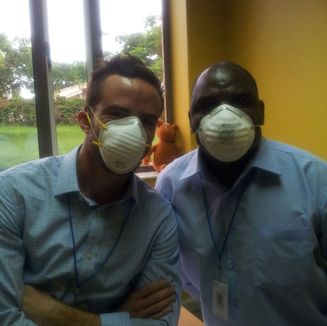COE implements TB infection prevention and control
|
Baylor College of Medicine Children’s Foundation-Malawi’s (BCM-CFM) Clinical Centre of Excellence (COE) was officially opened on 2nd November 2006. It is well known for providing high-quality pediatric TB/HIV services in Malawi and serves as a referral centre for complicated cases across the nation. The well-trained health service providers and patient-friendly infrastructure promotes an environment that facilitates delivery of high-quality health services. Baylor is committed to ongoing improvement of TB services within the COE.
In line with continuous quality improvement, Baylor conducted a comprehensive assessment of infection control procedures at the COE. Significant gaps were discovered in TB Infection, Prevention and Control (IPC), including lack of a TB -IPC committee to coordinate TB-IPC services, prompt triaging of patients presumed to have TB, routine education on cough hygiene, and separation or isolation of coughers in the waiting area. |
Ventilation systems were suboptimal: windows were not routinely opened, and instead of using recommended fans, air conditioning was routinely used, which allows for the survival of TB bacteria. In addition, N95 masks were not worn by staff in contact with presumed TB cases. Finally, due to the lack of a cough booth, patients were instructed to submit sputum at home and bring the samples to the clinic on the following day, resulting in delayed submission of samples for investigation of TB and requiring patients to make additional visits to the health facility. This not only delayed diagnosis but also led to patients failing to return to the clinic.
To address these gaps, a TB-IPC committee was established to develop and implement TB-IPC plans and policies appropriate to the context of the COE. To address delayed diagnosis and failing to return with a sputum sample the following day, a cough booth was constructed so that patients could submit sputum on the spot. This has facilitated same-day diagnosis and treatment.
Immediate triaging of presumed cases of TB, education on cough hygiene, and identification and isolation of coughers are now a routine aspect of clinic flow. To reduce nosocomial infection, windows are kept open, allowing improved air flow, and fans have been put in all high-risk areas to improve air circulation and reduce the risk of infection. Finally, N95 masks are now routinely given to all staff that are expected to be in contact with presumed TB cases to minimize the risk of contracting TB. With this approach, all important areas of TB–IPC are covered, including managerial, administrative, environmental and personal protective equipment (PPE).
This is remarkable improvement and an important step forward for the COE. A recent comprehensive assessment of TB-IPC at outreach sites showed a huge gap. We now hope to replicate implementation of these WHO-recommended TB-IPC practices at outreach clinics and Kamuzu Central Hospital. Ultimately this should help to decrease TB among patients who attend the COE and their families.
To address these gaps, a TB-IPC committee was established to develop and implement TB-IPC plans and policies appropriate to the context of the COE. To address delayed diagnosis and failing to return with a sputum sample the following day, a cough booth was constructed so that patients could submit sputum on the spot. This has facilitated same-day diagnosis and treatment.
Immediate triaging of presumed cases of TB, education on cough hygiene, and identification and isolation of coughers are now a routine aspect of clinic flow. To reduce nosocomial infection, windows are kept open, allowing improved air flow, and fans have been put in all high-risk areas to improve air circulation and reduce the risk of infection. Finally, N95 masks are now routinely given to all staff that are expected to be in contact with presumed TB cases to minimize the risk of contracting TB. With this approach, all important areas of TB–IPC are covered, including managerial, administrative, environmental and personal protective equipment (PPE).
This is remarkable improvement and an important step forward for the COE. A recent comprehensive assessment of TB-IPC at outreach sites showed a huge gap. We now hope to replicate implementation of these WHO-recommended TB-IPC practices at outreach clinics and Kamuzu Central Hospital. Ultimately this should help to decrease TB among patients who attend the COE and their families.

